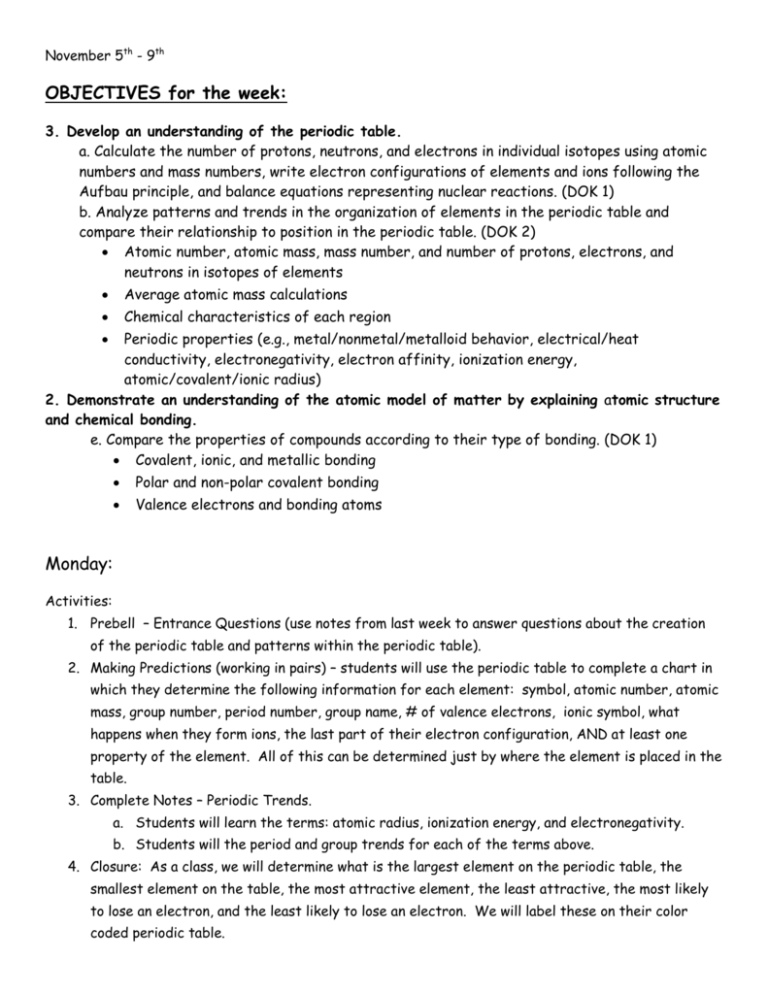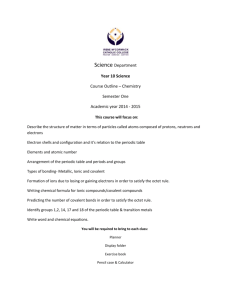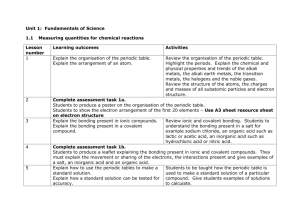11-5
advertisement

November 5th - 9th OBJECTIVES for the week: 3. Develop an understanding of the periodic table. a. Calculate the number of protons, neutrons, and electrons in individual isotopes using atomic numbers and mass numbers, write electron configurations of elements and ions following the Aufbau principle, and balance equations representing nuclear reactions. (DOK 1) b. Analyze patterns and trends in the organization of elements in the periodic table and compare their relationship to position in the periodic table. (DOK 2) Atomic number, atomic mass, mass number, and number of protons, electrons, and neutrons in isotopes of elements Average atomic mass calculations Chemical characteristics of each region Periodic properties (e.g., metal/nonmetal/metalloid behavior, electrical/heat conductivity, electronegativity, electron affinity, ionization energy, atomic/covalent/ionic radius) 2. Demonstrate an understanding of the atomic model of matter by explaining atomic structure and chemical bonding. e. Compare the properties of compounds according to their type of bonding. (DOK 1) Covalent, ionic, and metallic bonding Polar and non-polar covalent bonding Valence electrons and bonding atoms Monday: Activities: 1. Prebell – Entrance Questions (use notes from last week to answer questions about the creation of the periodic table and patterns within the periodic table). 2. Making Predictions (working in pairs) – students will use the periodic table to complete a chart in which they determine the following information for each element: symbol, atomic number, atomic mass, group number, period number, group name, # of valence electrons, ionic symbol, what happens when they form ions, the last part of their electron configuration, AND at least one property of the element. All of this can be determined just by where the element is placed in the table. 3. Complete Notes – Periodic Trends. a. Students will learn the terms: atomic radius, ionization energy, and electronegativity. b. Students will the period and group trends for each of the terms above. 4. Closure: As a class, we will determine what is the largest element on the periodic table, the smallest element on the table, the most attractive element, the least attractive, the most likely to lose an electron, and the least likely to lose an electron. We will label these on their color coded periodic table. Tuesday: Activities: 1. Prebell – Vocab Review 2. Chapter 5 Vocabulary Test 3. After test, quick worksheet on periodic trends. 4. Jigsaw Activity: Paper Plate Periodic Table!! a. Each student will be assigned a different element. Students must use paper plates and pom-poms to make 3-dimensional dot diagrams. On the back of their paper plate, they will answer various questions about their element. b. All students who have elements in the same group will get together to determine who is largest element in the group, who is the smallest, most attractive, least attractive, etc. c. Students will group themselves together by finding other students who are in the same period (horizontal row) as them. d. All paper plates will be taped to the wall in the proper order. 5. Closure – award certificates to the largest, smallest, most attractive, least attractive paper plates. Awards are based on periodic trends, not whose plate is the prettiest. Wednesday: Activities: 1. Prebell – Two discussion questions from the test 2. Quick Review 3. Chapter 5 Test 4. Define some terms from chapter 6 and 7 5. If time allows, we will begin Chapter 6. ***If necessary, I will make Wednesday a review day instead of test day!! Thursday: Activities: 1. Prebell – Pre-assessment for Chapter 6 2. Students will grade each other’s pre-assessments, so we can instantly see who knows the different types of bonds and who doesn’t. 3. Begin Chapter 6 Notes – a. List the three types of chemical bonds b. Show students how to classify the bonds as covalent, ionic, and metallic. 4. Worksheet – students will classify bonds as ionic, covalent, and metallic. 5. Resume notes a. Covalent bonding – how does a covalent bond form; single, double, and triple bonds; properties of a covalent molecule b. Ionic bonding – how does an ionic bond form; properties of ionic bonds. c. Metallic bonding – how does a metallic bond form, alloys 6. COMPOUNDS and FORMULAS a. Show the class a chemical formula. Discuss how many atoms of each element are in the formula. b. Percent Composition – demonstrate how to calculate percent composition c. Molar Mass – demonstrate how to calculate molar mass 7. Worksheet – Calculating molar mass and percent composition 8. Closure – show students an example of an ionic compound (borax crystal). Discuss how it exhibits properties of an ionic compound. Tell students that in the lab tomorrow, they will be making an ionic compound that they can use as a Christmas ornament. Friday: Activities: 1. Prebell – (a) Calculate the molar mass of Mg(NO3)2 (b) Determine the percent composition of each element in Mg(NO3)2 2. Prelab Discussion – read over lab handout, point out safety info, tell students what they will be doing in lab 3. Prelab Quiz – five questions on the information that was just discussed 4. LAB – Making Your Own Christmas Ornament (the ornament also represents an ionic compound) 5. Closure – Clean workspace, answer questions on lab handout







